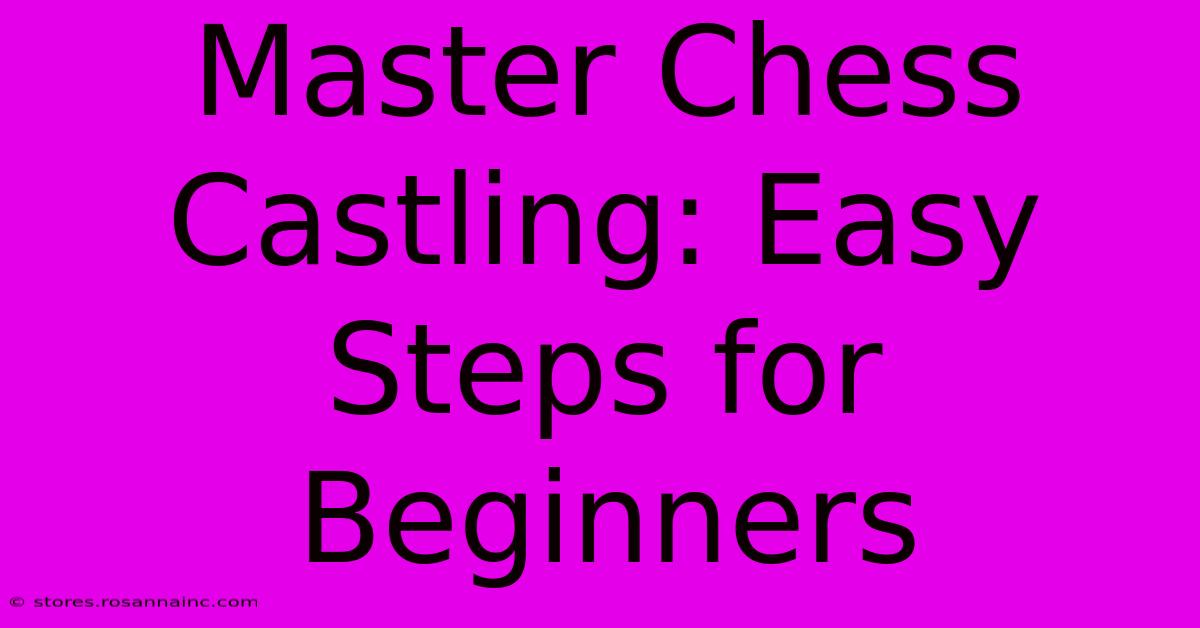Master Chess Castling: Easy Steps For Beginners

Table of Contents
Master Chess Castling: Easy Steps for Beginners
Castling. The word itself sounds regal, doesn't it? In chess, it's a crucial, powerful move that can significantly impact your game. But for beginners, it can feel daunting. This comprehensive guide will break down castling into easy-to-understand steps, helping you master this essential chess technique.
Understanding Castling: The King's Quick Escape
Castling is a special move that involves your king and one of your rooks (also known as castles). It's not just moving each piece individually; it's a combined maneuver that allows your king to reach a safer position and get your rook into the game quicker. Think of it as the king's quick escape to safety, and simultaneously unleashing a powerful rook.
What are the benefits?
- King Safety: Moving your king two squares towards your rook provides a much-needed safety net, especially in the opening stages of the game.
- Rook Activation: You bring a usually inactive rook into the heart of the action, adding to your offensive power.
- Strategic Advantage: A well-timed castling maneuver can control the center of the board and prepare for an assault on your opponent's position.
The Rules of Castling: Key Conditions to Remember
Before you can castle, you must meet several crucial conditions. Failing to satisfy even one of these renders castling illegal.
1. Neither the King nor the Rook has Moved:
This is the most fundamental rule. If your king or the rook you want to castle with has already moved during the game, castling with that rook is no longer permitted.
2. There are No Pieces Between the King and the Rook:
There must be absolutely no pieces standing between your king and the chosen rook. If other pieces are blocking the path, you cannot castle.
3. The King is Not in Check:
You cannot castle if your king is currently under attack (in check). Castling is a way to improve safety, not to escape immediate danger.
4. The King Does Not Pass Through Check:
Your king cannot move through any squares that are under attack. The path from its starting position to the final castled position must be entirely safe.
5. The King Does Not End in Check:
After castling, your king cannot end up in a checked position. It must be safely located in its new position.
How to Castle: A Step-by-Step Guide
Once you've verified that all the conditions above are met, castling is straightforward.
Kingside Castling (Short Castling):
- Move your King: Move your king two squares to the right, towards your kingside rook.
- Move your Rook: Simultaneously, move your kingside rook to the square that the king just passed over.
Queenside Castling (Long Castling):
- Move your King: Move your king two squares to the left, towards your queenside rook.
- Move your Rook: Simultaneously, move your queenside rook to the square that is two squares closer to the king.
Important Note: These moves are performed as a single, combined movement. You don't move the king, then the rook; it's one fluid action.
Mastering Castling: Practice and Strategy
The best way to learn castling is through practice. Play numerous games, and try to incorporate castling into your strategy. Experiment with both kingside and queenside castling to understand their advantages in different situations.
Consider these strategic points:
- Kingside vs. Queenside: Kingside castling is generally preferred as it's faster and protects your king quicker. Queenside castling is useful in specific situations but can expose your king to longer-range attacks.
- Timing: Don't rush into castling. Wait until you have developed your pieces and secured your king's safety.
- Opponent's Position: Consider your opponent's pieces and their potential threats before you decide to castle.
By understanding the rules and practicing consistently, you'll soon master castling and use it to your advantage, significantly improving your chess game. So, start practicing and elevate your chess skills!

Thank you for visiting our website wich cover about Master Chess Castling: Easy Steps For Beginners. We hope the information provided has been useful to you. Feel free to contact us if you have any questions or need further assistance. See you next time and dont miss to bookmark.
Featured Posts
-
From Fighters To Finances Decoding Ufc Ownership
Feb 11, 2025
-
What Is Port Wine A Beginners Guide To Portugals Liquid Gold
Feb 11, 2025
-
Ligue Des Champions Calendrier 2024
Feb 11, 2025
-
Sarah Mc Brides Birth Name Revealed
Feb 11, 2025
-
Cut And Shoot Texas More Than Just A Name
Feb 11, 2025
